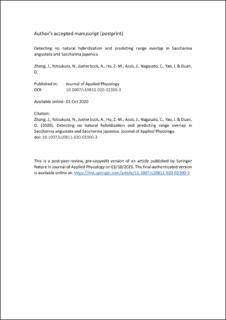| dc.contributor.author | Zhang, Jie | |
| dc.contributor.author | Yotsukura, Norishige | |
| dc.contributor.author | Jüterbock, Alexander Oliver | |
| dc.contributor.author | Hu, Zi-Min | |
| dc.contributor.author | Assis, Jorge | |
| dc.contributor.author | Nagasato, Chikako | |
| dc.contributor.author | Yao, Jianting | |
| dc.contributor.author | Duan, Delin | |
| dc.date.accessioned | 2020-12-04T09:47:47Z | |
| dc.date.available | 2020-12-04T09:47:47Z | |
| dc.date.created | 2020-10-19T20:45:18Z | |
| dc.date.issued | 2020 | |
| dc.identifier.citation | Zhang, J., Yotsukura, N., Jueterbock, A., Hu, Z.-M., Assis, J., Nagasato, C., Yao, J. & Duan, D. (2020). Detecting no natural hybridization and predicting range overlap in Saccharina angustata and Saccharina japonica. Journal of Applied Phycology. doi: | en_US |
| dc.identifier.issn | 1573-5176 | |
| dc.identifier.uri | https://hdl.handle.net/11250/2711869 | |
| dc.description | Author's accepted version (postprint). | |
| dc.description | This is an Accepted Manuscript of an article published by Springer Nature in Journal of Applied Phycology on 1 Oct. 2020. | |
| dc.description | Available online: https://link.springer.com/article/10.1007/s10811-020-02300-3 | |
| dc.description.abstract | Natural hybridization can play a significant role in evolutionary processes and influence the adaptive diversification and speciation of brown seaweeds. However, this phenomenon is as yet unknown in Saccharina kelps. Saccharina angustata and two varieties of Saccharina japonica (S. japonica var. japonica and S. japonica var. diabolica) partly overlap in distribution along the Pacific coast of Hokkaido, which makes them a good model system to study hybridization and introgression among species of the genus Saccharina. Based on 13 highly variable nuclear microsatellites and a mitochondrial marker, we assessed the genetic diversity levels of S. angustata for the first time and populations from Muroran to Shiranuka (western part of the Pacific coast in Hokkaido) exhibited highest genetic diversity. Genetic diversity of S. japonica was higher in S. japonica var. japonica as compared with S. japonica var. diabolica. There was significant genetic differentiation (FST > 0.25, p < 0.05) between S. japonica and S. angustata based on both markers. Moreover, there was poor genetic connectivity and limited interspecific hybridization among these closely related Saccharina species. Ecological niche models projected a northward expansion of both S. japonica and S. angustata under future climate scenarios and a range overlap between two species along the coast of Okhotsk Sea in Kamchatka Peninsula. The interspecific hybridization and genetic diversity among these kelps provide insights for kelp selection and cultivation as well as future conservation strategies of wild stocks. | en_US |
| dc.language.iso | eng | en_US |
| dc.publisher | Springer | en_US |
| dc.title | Detecting no natural hybridization and predicting range overlap in Saccharina angustata and Saccharina japonica | en_US |
| dc.type | Peer reviewed | en_US |
| dc.type | Journal article | en_US |
| dc.description.version | acceptedVersion | en_US |
| dc.subject.nsi | VDP::Matematikk og Naturvitenskap: 400::Zoologiske og botaniske fag: 480::Marinbiologi: 497 | en_US |
| dc.subject.nsi | VDP::Matematikk og Naturvitenskap: 400::Zoologiske og botaniske fag: 480 | en_US |
| dc.source.pagenumber | 10 | en_US |
| dc.source.journal | Journal of Applied Phycology | en_US |
| dc.identifier.doi | 10.1007/s10811-020-02300-3 | |
| dc.identifier.cristin | 1840704 | |
| dc.relation.project | Andre: National Natural Science Foundation of China | en_US |
| dc.relation.project | Andre: Shandong Provincial Natural Science Foundation | en_US |
| dc.relation.project | Andre: Foundation for Science and Technology of Portugal | en_US |
